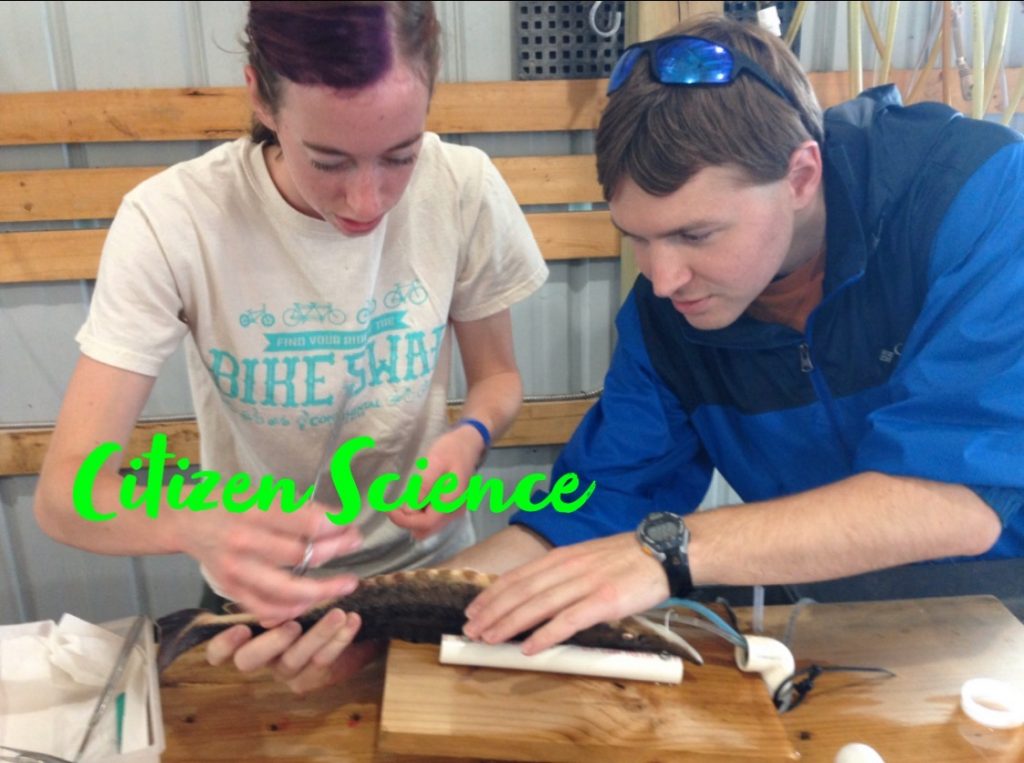
Citizen science is quantitative research conducted in collaboration with amateur (or community) scientists. In most cases, citizen scientists do not have a formal science background, but are passionate about a subject being rigorously studied. Often, researchers will activate citizen scientists to help answer complex questions which require data collection exceeding the research team’s capacity. Examples of successful citizen led research conducted in collaboration with Michigan State University include the Vernal Pool Mapping Project, the Michigan Marsh Bird Survey, and Invasive Species Monitoring (https://mnfi.anr.msu.edu/programs/citizen-science).
Beginning in 2020, the Black River Streamside Sturgeon Rearing Facility will deploy a citizen-led science program. Recent research conducted by Michigan State University indicates that local and migratory predator species dramatically reduce the number of lake sturgeon larvae which survive the vulnerable drifting stage (Waraniak et al. 2017a; 2017b; 2018; 2019). Researchers continue to evaluate the intra-annual variability in predator biomass as it relates to lake sturgeon larval predation. Black River will deploy a videography system that records fish entering the Black River in NE Michigan and the time and date of passage up- and down-stream. We will develop a species identification key that allows users to identify fish species. An instream-size scale will allow estimation of fish body size. We will host the videos and background materials on fish migration, reproductive ecology, and predator-prey relationships as an expansion of this website. We will work with K-12 STEM educators to develop lesson plans to direct student learning. Our eventual goal is to quantify the biomass of lake sturgeon larval predators moving up- and down-stream before, during, and after the larval drift period each year.
The web-based “Citizen-science” program and e-learning resources will also extend opportunities for education and community engagement to all citizens and stakeholder groups. The e-learning platform will allow students and citizens to make observations, synthesize information, and draw conclusions in a web-hosted environment. Citizen science can help community members learn more about scientific processes, become more engaged in local issues, and better understand policy decisions.
Teachers and community members learn knowledge and skills to explore Great Lakes fisheries and a local watershed from area experts growing and developing as professional educators and Great Lakes watershed stewards. Teachers take their experiences into the classroom where students increase their understanding of the Great Lakes environment improving Great Lakes Literacy, environmental stewardship and making environmental changes for the better.
In preparation for the Citizen Science Program, Black River “beta-tested” our videography system in 2019. Here, we present these videos without an identification key and are asking that you view each of these short video clips, and using the attached poll-style questions, identify as many of the fish as possible. Michigan State University Black River Streamside Rearing Facility would like to thank all participants for engaging in the early stages of this project, and look forward to deploying the full program in Fall, 2020.
Cited works (find full publications on the “publications” page)
Waraniak, J. M., Blumstein, D., and K. T. Scribner. 2017. Barcoding PCR primers detect larval lake sturgeon (Acipenser fulvescens) in diets of piscine predators. Conservation Genetics Resources. 10(2): 259-268.
Waraniak, J. M., S. A. Valentine, and K.T. Scribner. 2017. Effects of changes in alternative prey densities on predation of drifting larval Lake Sturgeon (Acipenser fulvescens). J. Freshwater Ecology. 32: 619-632.
Waraniak, J. M., Baker, E. A., and K.T. Scribner. 2018. Molecular diet analysis reveals predator-prey community dynamics and environmental factors affect predation of larval lake sturgeon (Acipenser fulvescens) in a natural system. J. Fish Biol. doi: 10.1111/jfb.13726.
Waraniak, J. M., Marsh, T. L., and K. T. Scribner. 2019. 18s rRNA metabarcoding diet analysis of predatory fish community across seasonal changes in prey availability. Ecology and Evolution. DOI: 10.1002/ece3.4857